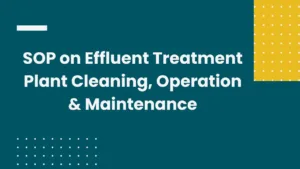SOP on Effluent Treatment Plant Cleaning, Operation & Maintenance

SOP on Effluent Treatment Plant Cleaning, Operation & Maintenance
1.0 Purpose: This SOP describes a procedure for the Cleaning , Operation & Maintenance of Effluent Treatment Plant (ETP)
2.0 Scope: This SOP is applicable to all Effluent Treatment Plant (ETP)
3.0 Responsibility: It is the responsibility of Quality Assurance Manager to ensure that the procedure is followed.
4.0 Materials and Equipment Used:
4.1 Materials:
4.1.1 Chemicals:
-
- Coagulants (e.g., aluminum sulfate, ferric chloride) for destabilizing particles.
- Flocculants (e.g., polyacrylamide) for agglomerating suspended solids.
- pH adjusters (acids or bases) for maintaining the optimal pH range.
- Oxidizing agents (e.g., chlorine, hydrogen peroxide) for disinfection.
- Activated carbon for adsorption of organic compounds.
4.1.2 Filter Media:
-
- Sand filters for physical filtration.
- Activated carbon filters for chemical adsorption.
4.1.3 Biological Media:
-
- Biofilm carriers for attached growth systems (like Moving Bed Biofilm Reactors or Biofilters).
4.1.4 Absorbents:
-
- Absorbent materials (such as activated carbon) for removing trace contaminants.
4.2 Equipment:
4.2.1 Pumps:
-
- Centrifugal pumps for transferring water between treatment stages.
- Diaphragm pumps for dosing chemicals.
- Submersible pumps for lifting water from sumps.
4.2.2 Mixers and Agitators:
-
- Mechanical or pneumatic mixers for promoting coagulation and flocculation.
- Agitators to keep solids in suspension.
4.2.3 Clarifiers and Settlers:
-
- Sedimentation tanks or clarifiers for settling suspended solids.
- Lamella clarifiers for enhanced settling.
4.2.4 Aeration Systems:
-
- Aeration tanks with diffusers for biological treatment.
- Mechanical aerators for surface aeration.
4.2.5 Bioreactors:
-
- Sequential Batch Reactors (SBRs) or Continuous Flow Reactors for biological treatment.
4.2.6 Chemical Dosing Systems:
-
- Automatic dosing systems for coagulants, flocculants, and pH adjusters.
4.2.7 Monitoring Instruments:
-
- pH meters, turbidity meters, and other sensors for real-time monitoring.
- Flow meters to measure the flow of influent and effluent.
4.2.8 Sludge Handling Equipment:
-
- Sludge thickeners for concentrating sludge.
- Sludge dewatering equipment (e.g., filter presses, centrifuges).
- Sludge drying beds.
4.2.9 Disinfection Systems:
-
- UV disinfection systems.
- Chlorination systems.
4.2.10 Safety Equipment:
-
- Personal protective equipment (PPE) for operators.
- Emergency eyewash stations and showers.
4.2.11 Control and Automation Systems:
-
- SCADA (Supervisory Control and Data Acquisition) systems.
- Programmable Logic Controllers (PLCs) for automation.
4.2.12 Laboratory Equipment:
-
- Instruments for water quality analysis.
- Sample collection and testing equipment.
4.3 Maintenance Tools:
4.3.1 Wrenches, Screwdrivers, and Tools:
-
- Basic tools for routine equipment maintenance.
4.3.2 Lubrication Equipment:
-
- Grease guns and lubricants for moving parts.
4.3.3 Cleaning Tools:
-
- High-pressure hoses for cleaning filters and tanks.
4.3.4 Safety Gear:
-
- Helmets, gloves, safety glasses, and other personal protective equipment.
4.3.5 Spare Parts:
5.0 Procedure
5.1 Cleaning Procedure
5.1.1 Drain out the treatment tank for left overs.
5.1.2 Fill the tank with tap water, close the lid and start the stirrer for 15 minutes.
5.1.3 Drain out the washing through sludge collector tanks and carbon bed.
5.1.4 Take out the sludge collecting bags from the sludge collectors and rinse the tanks with tap water.
5.1.5 Finally clean the effluent treatment plant by filling the tap water in treatment tank and drain out through sludge collector tanks and carbon bed.
5.2 Operational Procedure
5.2.1 Fill the treatment tank with about 300 liters of tap water.
5.2.2 Add the effluents (solids/liquids) to the tank and stir for 15 minutes.
5.2.3 Check the pH of mixed effluent water.
5.2.3.1 If pH is acidic (i.e. less than 5.0), add a sufficient quantity of 10% w/v solution of lime to raise the pH 7.0 0.2.
5.2.3.2 If pH is alkaline (i.e. more than 9.0), add 10% w/v solution to Alum or Ferrous sulphate to drop the pH 7.0 0.2.
5.2.4 Stir the mixture for 30 minutes.
5.2.5 Dissolve 25gm of Polyelectrolyte in 2 liters of tap water, add to the tank and stir for 30 minutes.
5.2.6 Switch off the stirrer and allow the mixture to separate for 2 hours.
5.2.7 Pass the separated solids in sludge collector tanks containing jute bags.
5.2.8 Take out the jute bags, completely dry in air and sunlight. Remove the dried sludge in Polythene bags and send for deep burial in land far away from the residential area.
5.2.9 Pass the treated water through carbon bed to drainage holes.
5.2.10 Collect the treated water at least once in a month for testing and record the results.
5.3 Maintenance Procedure
5.3.1 Clean the ETP at least once in a week.
5.3.2 Clean the sludge collecting bags every time after use.
5.3.3 Change the carbon bed at least once in a month.
5.3.4 Grease the electrically driven motor at least once in a month.
Also, Visit:
B. Pharma Notes | B. Pharma Notes | Study material Bachelor of Pharmacy pdf